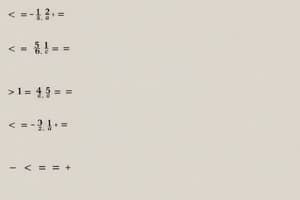Podcast
Questions and Answers
A proper fraction is a fraction where the numerator is greater than the denominator.
A proper fraction is a fraction where the numerator is greater than the denominator.
False (B)
To multiply fractions, you add the numerators and denominators.
To multiply fractions, you add the numerators and denominators.
False (B)
A mixed number is a combination of a whole number and an improper fraction.
A mixed number is a combination of a whole number and an improper fraction.
False (B)
Fractions can be added only if they have different denominators.
Fractions can be added only if they have different denominators.
A fraction is in its simplest form when the numerator and denominator are both prime numbers.
A fraction is in its simplest form when the numerator and denominator are both prime numbers.
Equivalent fractions have different values.
Equivalent fractions have different values.
To divide fractions, you subtract the second fraction from the first.
To divide fractions, you subtract the second fraction from the first.
Fractions can be compared by simply looking at their numerators.
Fractions can be compared by simply looking at their numerators.
Flashcards are hidden until you start studying
Study Notes
Definition and Notation
- A fraction is a way to represent a part of a whole.
- It consists of a numerator (top number) and a denominator (bottom number) separated by a horizontal line.
- The notation for a fraction is:
a/bwhereais the numerator andbis the denominator.
Types of Fractions
- Proper Fraction: A fraction where the numerator is less than the denominator. Example:
1/2 - Improper Fraction: A fraction where the numerator is greater than or equal to the denominator. Example:
3/2 - Mixed Number: A combination of a whole number and a proper fraction. Example:
2 1/3
Operations with Fractions
- Addition: To add fractions, they must have the same denominator. Then, add the numerators and keep the same denominator.
- Subtraction: To subtract fractions, they must have the same denominator. Then, subtract the numerators and keep the same denominator.
- Multiplication: To multiply fractions, multiply the numerators and multiply the denominators.
- Division: To divide fractions, invert the second fraction (i.e., flip the numerator and denominator) and then multiply.
Simplifying Fractions
- A fraction is in its simplest form when the numerator and denominator have no common factors.
- To simplify a fraction, divide both the numerator and denominator by their greatest common divisor (GCD).
Equivalent Fractions
- Equivalent fractions are fractions that have the same value.
- They can be created by multiplying or dividing both the numerator and denominator by the same number.
Comparing Fractions
- To compare fractions, convert them to equivalent fractions with the same denominator.
- The fraction with the larger numerator is the larger fraction.
Definition and Notation
- A fraction represents a part of a whole, consisting of a numerator and a denominator separated by a horizontal line.
- The notation for a fraction is
a/b, whereais the numerator andbis the denominator.
Types of Fractions
- A proper fraction has a numerator less than the denominator (e.g.,
1/2). - An improper fraction has a numerator greater than or equal to the denominator (e.g.,
3/2). - A mixed number combines a whole number and a proper fraction (e.g.,
2 1/3).
Operations with Fractions
- To add fractions, they must have the same denominator; add the numerators and keep the same denominator.
- To subtract fractions, they must have the same denominator; subtract the numerators and keep the same denominator.
- To multiply fractions, multiply the numerators and multiply the denominators.
- To divide fractions, invert the second fraction and then multiply.
Simplifying Fractions
- A fraction is in its simplest form when the numerator and denominator have no common factors.
- To simplify a fraction, divide both the numerator and denominator by their greatest common divisor (GCD).
Equivalent Fractions
- Equivalent fractions have the same value and can be created by multiplying or dividing both the numerator and denominator by the same number.
Comparing Fractions
- To compare fractions, convert them to equivalent fractions with the same denominator.
- The fraction with the larger numerator is the larger fraction.
Studying That Suits You
Use AI to generate personalized quizzes and flashcards to suit your learning preferences.





